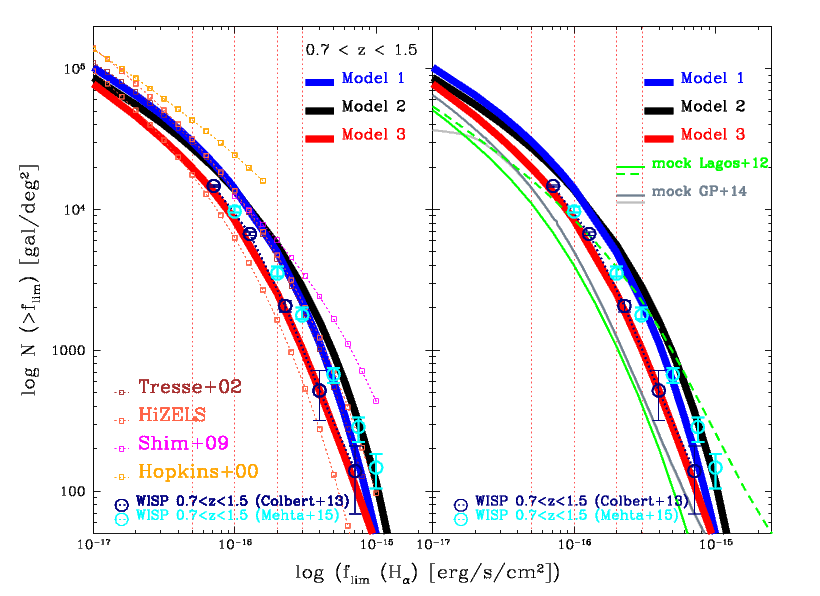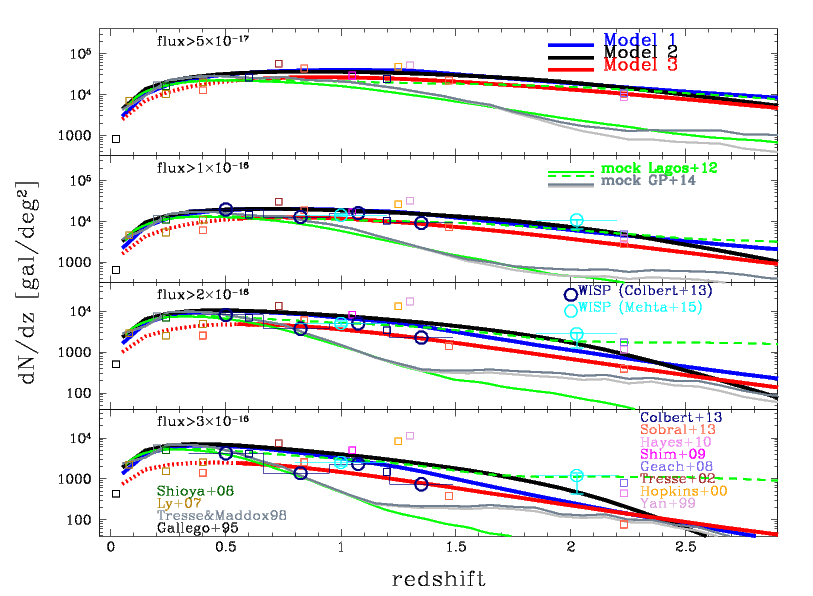Modelling the number density of Halpha emitters for future spectroscopic near-IR space missions:
CONTEXT. The future space missions Euclid (Laureijs et al. 2011) and WFIRST-AFTA (Spergel et al. 2015; Green et al. 2012) will use the Halpha emission line to measure the redshifts of tens of millions of galaxies. The Halpha luminosity function at z > 0.7 is one of the major sources of uncertainty in forecasting cosmological constraints from these missions.
AIMS. We construct unified empirical models of the Halpha luminosity function spanning the range of redshifts and line luminosities relevant to the redshift surveys proposed with Euclid and WFIRST-AFTA.
METHODS. By fitting to observed luminosity function from Halpha surveys, we build three models for its evolution. Different fitting methodologies, functional forms for the luminosity function, subsets of the empirical input data, and treatment of systematic errors are considered to explore the robustness of the results.
RESULTS. Functional forms and model parameters are provided for all three models, along with the counts and redshift distributions up to z = 2.5 for a range of limiting fluxes (FHalpha > 0.5, 3 10^-16 erg/s/cm^2), relevant for future space missions. For instance, in the redshift range 0.90 < z < 1.8, our models predict an available galaxy
density in the range 7700 - 13300 and 2000-4800 deg^-2, respectively at fluxes above FHalpha > 1 and 2 10^-16 erg cm^-2 s^-1 , and 32000-48000 for FHalpha > 0.5 10^-16 erg cm^-2 s^-1 in the extended redshift range 0.40 < z < 1.8. We consider also the implications of our empirical models for the global Halpha luminosity density of the Universe, and the closely related cosmic star formation history.
N.B. The models and luminosity functions presented here are for Halpha only, not Halpha+[NII].
Our focus is on predictions for the yield of galaxy redshift surveys, so we work in terms of
observed Halpha flux, i.e. with no correction for extinction in the target galaxy.
Complete tables (README) for the redshift distribution (dN/dz) for a range of limiting fluxes (from 0.1 to 100 erg cm-2 s-1 are available here for Model 1, Model 2, Model 3:
Single files:
Model 1: dNdz_model1.out (Model 1)
Model 2: dNdz_model2.out (Model 2)
Model 3: dNdz_model3.out (Model 3)
All the files in a single tar: Halpha.tar.gz
Counts and number density of Halpha emitters:

Figures: {Left panel:} Cumulative Halpha number counts, integrated over the redshift ranges z=0.7-1.5$ (WISP range).
The observed counts from the WISP survey (Colbert et al. 2013) are shown (blue circles) and from new WISP analysis by Mehta et al. (2015) (cyan circles), and compared to the empirical Model 1, 2, and 3, (blue, black and red lines, respectively). Also shown (as dotted lines and empty squares) are the counts obtained integrating the observed LFs (see legend) in the same redshift range. {Right panel:} The same cumulative Halpha number counts compared to the predictions from Lagos et al. 2012 mocks (green dashed and solid lines using intrinsic and extincted Halpha fluxes, respectively) and Gonzalez-Perez et al. 2014 mocks (dark and light grey for H27 and H24 mocks, respectively)

Figure: The Halpha redshift distribution above various flux thresholds (from 0.5 10^-16 erg cm^-2 s^-1 to 3 10^-16 erg cm^-2 s^-1, from top to bottom panels). Observed redshift distributions are indicated with open circles, while data obtained integrating LFs are shown with squares. HalphaLF predictions from Model 1, 2, 3 are shown as thick solid lines.
The predictions from L12 mocks (green dashed and solid lines using intrinsic and extincted Halpha fluxes, respectively) and GP14 mocks (dark and light grey for H27 and H24 mocks, respectively) are also shown.
Lucia Pozzetti
home page
by Lucia Pozzetti
Last
update: March 4, 2016




